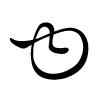ゆ
Japanese

| Stroke order | |||
|---|---|---|---|
Pronunciation
Etymology 1
Derived in the Heian period from writing the man'yōgana kanji 由 in the cursive sōsho style.
Syllable
ゆ (romaji yu)
- The hiragana syllable ゆ (yu). Its equivalent in katakana is ユ (yu). It is the thirty-seventh syllable in the gojūon order; its position is や行う段 (ya-gyō u-dan, “row ya, section u”).
See also
- (Hiragana) 平仮名; あぁ, いぃ, うぅゔ, えぇ, おぉ, かゕが, きぎ, くぐ, けゖげ, こ𛄲 (𛄲)ご, さざ, しじ, すず, せぜ, そぞ, ただ, ちぢ, つっづ, てで, とど, な, に, ぬ, ね, の, はばぱ, ひびぴ, ふぶぷ, へべぺ, ほぼぽ, ま, み, む, め, も, やゃ, 𛀆, ゆゅ, 𛀁, よょ, らら゚, りり゚, るる゚, れれ゚, ろろ゚, わゎわ゙, ゐ𛅐 (𛅐)ゐ゙, 𛄟 (𛄟), ゑ𛅑 (𛅑)ゑ゙, を𛅒 (𛅒)を゙, ん, ー, ゝ, ゞ, ゟ
Etymology 2
Attaches to the irrealis form of verbs. Conjugates as a lower bigrade: ye, ye, yu, yuru, yure, -.
Suffix
- expresses passiveness
- expresses possibility
- expresses natural, spontaneous occurrence
Derived terms
Okinawan
Etymology
From Proto-Ryukyuan *wo, from Proto-Japonic *wo. Cognate with standard Japanese を (wo).
Pronunciation
Particle
ゆ (rōmaji yu)
- (archaic, literary) A case particle.
- (archaic, literary, with transitive verb) An accusative case particle: a grammatical marker following the direct object.
- 誰ゆ恨みとぅてぃ鳴ちゅが浜千鳥。
- Taru-yu uramituti nachuga hamachiduri.
- (please add an English translation of this usage example)
- (archaic, literary, with intransitive verb) away from, off
- (archaic, literary, with intransitive verb) along, following a specified route, track, orbit, etc.
- (archaic, literary, with transitive verb) An accusative case particle: a grammatical marker following the direct object.
References
Categories:
- Japanese terms with IPA pronunciation
- Japanese lemmas
- Japanese syllables
- Japanese syllables in Hiragana script
- Japanese suffixes
- Japanese hiragana
- Okinawan terms inherited from Proto-Ryukyuan
- Okinawan terms derived from Proto-Ryukyuan
- Okinawan terms inherited from Proto-Japonic
- Okinawan terms derived from Proto-Japonic
- Okinawan terms with IPA pronunciation
- Okinawan lemmas
- Okinawan particles
- Okinawan terms with archaic senses
- Okinawan literary terms
- Okinawan terms with usage examples